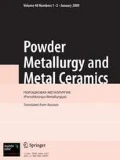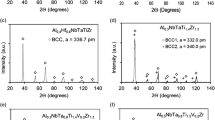X-ray diffraction, scanning electron microscopy, and micromechanical tests are employed to study the phase and structural transformations in the Al–Cu–Ni–Fe–Ti and Al–Cu–Ni–Fe–Cr equiatomic powder compositions during mechanical activation and subsequent pressure sintering. The mechanical properties of the high-entropy alloys are examined as well. It is revealed that the AlCuNiFeTi and AlCuNiFeCr nanocrystalline high-entropy alloys produced by mechanical activation consist of supersaturated substitutional solid solutions with bcc crystal structure. It is established that the alloys become three-phase after sintering and consist mainly of bcc solid solutions and an insignificant amount (to 5%) of two fcc solid solutions with different lattice parameters. It is shown that the sintered AlCuNiFeTi and AlCuNiFeCr alloys are characterized by high strength, and their Vickers microhardness reaches 11.2 ± 0.3 GPa and 9.5 ± 0.25 GPa, respectively.




Similar content being viewed by others
References
J. W. Yeh, S. K. Chen, S. J. Lin, et al., “Nanostructured high-entropy alloys with multiple principal elements: novel alloy design concepts and outcomes,” J. Adv. Eng. Mater., 6, No. 5, 299–303 (2004).
S. Ranganathan, “Alloyed pleasures: multimetallic cocktails,” Curr. Sci., 85, No. 10, 1404–1406 (2003).
J. W. Yeh, Y. L. Chen, and S. J. Lin, “High-entropy alloys―a new era of exploitation,” Mater. Sci. Forum, 560, 1–9 (2007).
J. H. Pi, Y. Pan, L. Zhang, et al., “Microstructure and property of AlTiCrFeNiCu high-entropy alloy,” J. Alloys Compd., 18, No. 509, 5641–5645 (2011).
X. Yang, Y. Zhang, and P. K. Liaw, “Microstructure and compressive properties of NbTiVTaAl x high entropy alloys,” Proc. Eng., 36, 292–298 (2012).
S. A. Firstov, V. F. Gorban’, N. A. Krapivka, et al., “Mechanical properties of as-cast multicomponent alloys are high temperatures,” Sovr. Probl. Fiz. Materialoved., Issue 17, 126–139 (2008).
O. V. Sobol’, A. A. Andreev, V. F. Gorban’, et al., “On the method for analyzing structurally stressed state of vacuum arc coatings in the multielement high-entropy Ti–V–Zr–Nb–Hf system and superhard nitrides on its basis,” Pis’ma Zh. Tekh. Fiz., 38, No. 13, 41–46 (2012).
S. Guo and C. T. Liu, “Phase stability in HEAs: formation of solid-solution phase or amorphous phase,” Progr. Mater. Sci.: Mater. Int., No. 21, 433–446 (2011).
F. R. de Boer, R. Boom, W. C. M. Mattens, et al., Cohesion in Metals, Elsevier Science Publisher, New York (1988), p. 482.
V. F. Gorban’, V. A. Nazarenko, N. I. Danilenko, et al., “Effect of deformation on the structure and mechanical properties of the Fe25Cr20Ni20Co10Mn15Al10 high-entropy alloy,” Deform. Razrush. Mater., No. 9, 2–6 (2013).
Ya. S. Umanskii, Yu. A. Skakov, A. N. Ivanov, et al., Crystallography, X-Ray Diffraction, and Electron Microscopy [in Russian], Metallurgiya, Moscow (1982), p. 632.
S. R. Ignatovich and I. M. Zakiev, “Universal Micron Gamma micro/nanoindentation meter,” Zavod. Lab., 77, No. 1, 61–67 (2011).
S. A. Firstov, V. F. Gorban’, and É. P. Pechkovskii, “Automated indentation to establish ultimate hardness, elastic strain, and associated stress of materials,” Materialovedenie, No. 8, 15–21 (2008).
S. Varalakshmi, M. Kamaraj, and B. S. Murty, “Formation and stability of equiatomic and nonequiatomic nanocrystalline CuNiCoZnAlTi high-entropy alloys by mechanical alloying,” Metall. Mater. Trans. A, 10, No. 41, 2703–2709 (2010).
N. I. Noskova and R. R. Mulyukov, Submicrocrystalline and Nanocrystalline Metals and Alloys [in Russian], Ural. Otdel. Ros. AN, Ekaterinburg (2003), p. 279.
C. Suryanarayana, “Mechanical alloying and milling,” Progr. Mater. Sci., 46, 1–184 (2001).
A. Takeuchi and A. Inoue, “Quantitative evaluation of critical cooling rate for metallic glasses,” Mater. Sci. Eng. A, 304–306, 446–451 (2001).
K. B. Zhang, Z. Y. Fu, J. Y. Zhang, et al., “Nanocrystalline CoCrFeNiCuAl high-entropy solid solution synthesized by mechanical alloying,” J. Alloys Compd., 485, No. 1–2, 31–34 (2009).
S. A. Firstov, V. F. Gorban’, N. A. Krapivka, et al., “Strengthening and mechanical properties of as-cast high-entropy alloys,” Kompoz. Nanostruct., No. 2, 5–20 (2012).
Author information
Authors and Affiliations
Corresponding author
Additional information
Translated from Poroshkovaya Metallurgiya, Vol. 55, Nos. 3–4 (508), pp. 37–52, 2016.
Rights and permissions
About this article
Cite this article
Yurkova, A.I., Chernyavskii, V.V. & Gorban’, V.F. Structure and Mechanical Properties of High-Entropy AlCuNiFeTi and AlCuNiFeCr Alloys Produced by Mechanical Activation Followed by Pressure Sintering. Powder Metall Met Ceram 55, 152–163 (2016). https://doi.org/10.1007/s11106-016-9790-3
Received:
Published:
Issue Date:
DOI: https://doi.org/10.1007/s11106-016-9790-3




